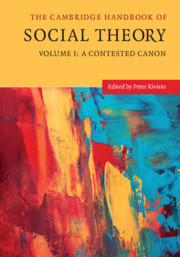Book contents
- The Cambridge Handbook of Social Theory
- The Cambridge Handbook of Social Theory
- Copyright page
- Contents
- Figures
- Tables
- Contributors
- Preface
- 1 The Emergence of Social Theory
- 2 “What Is a Classic?”
- 3 Karl Marx
- 4 The Marxist Legacy
- 5 Émile Durkheim: Theorist of Solidarity
- 6 What’s in a Name?
- 7 Max Weber
- 8 Weberian Social Theory
- 9 Georg Simmel and the Metropolitization of Social Life
- 10 Pounding on Parsons: How Criticism Undermined the Reputation of Sociology’s Incurable Theorist
- 11 Symbolic Interactionism
- 12 Erving Goffman and Dramaturgical Sociology
- 13 Structuralism
- 14 Norbert Elias, Civilising Processes, and Figurational (or Process) Sociology
- 15 Phenomenology and Social Theory
- 16 Pierre Bourdieu: An Intellectual Legacy
- 17 Developing Ethnomethodology: Garfinkel on the Constitutive Interactional Practices in Social Systems of Interaction
- 18 Jürgen Habermas
- 19 Anthony Giddens, Structuration Theory, and Radical Politics
- Index
- References
17 - Developing Ethnomethodology: Garfinkel on the Constitutive Interactional Practices in Social Systems of Interaction
Published online by Cambridge University Press: 03 December 2020
- The Cambridge Handbook of Social Theory
- The Cambridge Handbook of Social Theory
- Copyright page
- Contents
- Figures
- Tables
- Contributors
- Preface
- 1 The Emergence of Social Theory
- 2 “What Is a Classic?”
- 3 Karl Marx
- 4 The Marxist Legacy
- 5 Émile Durkheim: Theorist of Solidarity
- 6 What’s in a Name?
- 7 Max Weber
- 8 Weberian Social Theory
- 9 Georg Simmel and the Metropolitization of Social Life
- 10 Pounding on Parsons: How Criticism Undermined the Reputation of Sociology’s Incurable Theorist
- 11 Symbolic Interactionism
- 12 Erving Goffman and Dramaturgical Sociology
- 13 Structuralism
- 14 Norbert Elias, Civilising Processes, and Figurational (or Process) Sociology
- 15 Phenomenology and Social Theory
- 16 Pierre Bourdieu: An Intellectual Legacy
- 17 Developing Ethnomethodology: Garfinkel on the Constitutive Interactional Practices in Social Systems of Interaction
- 18 Jürgen Habermas
- 19 Anthony Giddens, Structuration Theory, and Radical Politics
- Index
- References
Summary
This chapter focuses on the historical development of ethnomethodology, presenting Harold Garfinkel’s career-spanning efforts to develop a theory of the constitutive interactional practices in social systems of interaction. Specifically, it examines five stages in that developmental process: 1939–1942 in North Carolina; 1942–1946 in the Army Air Force; 1946-1952 at Harvard; 1952–1953 at Princeton; and finally his long career at UCLA, extending from 1954 to 2011.
Anne Rawls is Professor of Sociology at Bentley University. Her research interests focus broadly on social theory, with emphases on ethnomethodology, communication studies, democracy, and race relations. In addition to publishing extensively on Garfinkel and ethnomethodology, she has also published on Durkheim and DuBois. She recently coauthored Tacit Racism with Waverly Duck.
- Type
- Chapter
- Information
- The Cambridge Handbook of Social Theory , pp. 343 - 368Publisher: Cambridge University PressPrint publication year: 2020
References
References
Unpublished Manuscripts by Harold Garfinkel in the Garfinkel Archive
Coauthored Works by Garfinkel in the Garfinkel Archive
- 1
- Cited by



